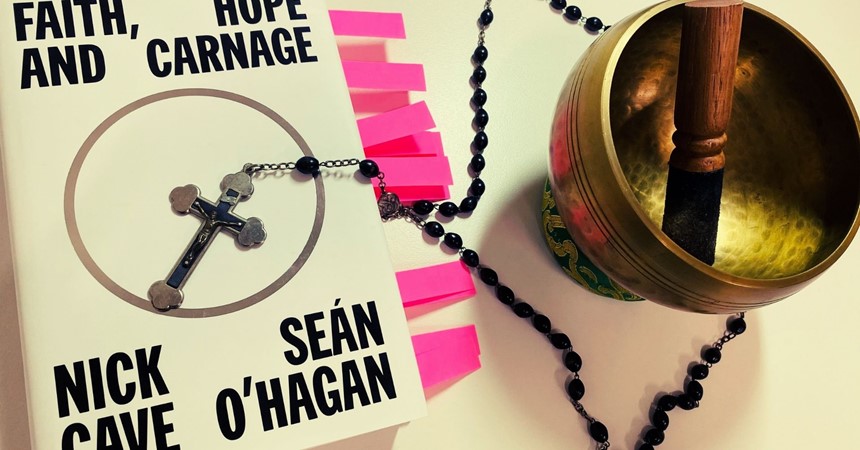One person who attended was Peter Carlin, he brought along with him the recently published book by Nick Cave and Sean O’Hagan titled Faith, Hope and Carnage. I was struck when Peter spoke about the impact that this book has had on restoring his faith with God and the lessons we can all learn from diving deep into the dialogue within the book.
Faith, Hope and Carnage is essentially the transcripts of several long conversations between Cave and O’Hagan that began in 2020 during COVID. The book recalls Caves childhood, times of addiction, loss of his sons and his deep faith, which is something that many people do not realise about Nick Cave.
In a recent conversation with Peter, he spoke to me about the continued impact and influence of Nick Cave’s theology revealed in the book and how he can relate to Cave’s creative process.
For the last 15 years as part of a retirement plan, Peter and his wife Jane have infused the little country town with international art and design and delicious food. Like many creatives from Sydney and other parts of Australia now call Murrurundi home. While born and raised in Newcastle Peter left home at an early age to study Industrial Design in Copenhagen and has lived, worked and been head hunted in many places around the world and in Australia. It is no wonder that the art and design pieces that were on display in Peter and his wife Janes gallery/café at the old bank building were questioned by those passing through as to where else they could be seen. Many art pieces were unique and acquired through Peters European and Asian connections. Peter has an eye and ear for detail.
Peter reflects on his love of music from an early age, from classical to jazz to everything in between. He recalls on Sunday after mass and lunch the family would gather around the piano or record player to listen to an eclectic mix of compositions, all having a strong sense of story and journey.
When Peter saw the book Faith, Hope and Carnage reviewed in a weekender magazine, he thought this is something he would like to read. In the review which focused on the faith aspects of the book, states that Cave is drawn to traditional Christian ideas, fascinated with the bible and in particular the life of Christ and admits that these elements have been a powerful influence in his work from the very start.
Peter recalls from his childhood a time when his father took him to a mission centre for the homeless in Newcastle and made a point about not judging others by their looks. His father told him that the man in the corner had been a doctor and because of an unfortunate turn of events in his life, it led him to be homeless.
Peter who previously was not necessarily a Nick Cave fan has found great wisdom in his words and has highlighted many significant sections of the conversations, obvious with the multiple bookmarks inside the pages of the book.
In chapter nine the ‘Astonishing Idea’ Cave speaks about the need to be patient, often we need to do the waiting alone, be alert so we don’t lose our nerve because it is to our peril that we miss the astonishing idea, the Jesus idea. We can be side tracked; it is easy to be side tracked. People so easily become distracted, Sean asked Nick at one point, are you afraid that you will lose some of your audience along the way due to your belief and faith, Nick points out that the alternative is much worse. It is vital to learn and grow, as not only through creativity but also as seekers in understanding the truth. At times religion can try to smooth things over, but life is not smooth, there are ridges and cracks.
Peter feels that through contemplation of the dialogue his vision has been sharpened.
“Here is a guy, a rock in rock star who admits having done things wrong in his life and creates a space in the Red Hand Files were people can write to him and ask any question and he takes the time to answer and talk to them. He does not judge others but in fact takes an internal stance on how we should be like Christ ourselves to everyone. Even in Nick Cave’s darkest hours of addiction, he was in and out of churches, he was always seeking. We need to be mindful of how we provide outreach to those in need. In a recent visit to the Congo, Pope Francis who in his wheelchair spoke about how people haven’t left the church, the church has left the people.”
The book helps us consider where we are sitting in all of this? How far are you willing to go to reach out to people? Not waiting for them to come to you, but you going to them. If people do come to you, how are you going to address them, how are you going to be the face to God to them, the living Gospel? How can we be merciful people? Perhaps we need to start to look with fresh eyes and approach these opportunities in creative ways. There are many points of finding light in the darkness throughout this book.
As we come to the end of our Lenten journey, I leave you with this image that Nick Cave uses to describe the birthing of a creative idea.
On the third day standing at the tomb are Mother Mary and Mary Magdalene, when Christ appears to them is like when a creative idea is given life.
Follow mnnews.today on Facebook.
